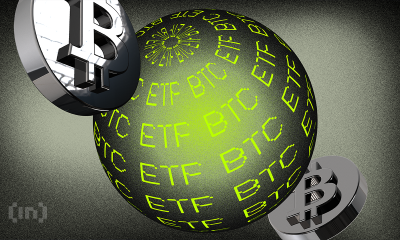Market
Bitcoin ATH, Binance Drama, Shiba Inu Plans

This week in crypto, a lot happened across different ecosystems, with momentum reinvigorated by the broader market’s prevailing bullish sentiment. Besides Bitcoin’s (BTC) testing unchartered territory, the following are some of the updates you won’t want to miss.
For starters, Bitcoin established a new local top at $93,265 on Binance amid other BTC-related chatter. Other notable updates include developments on Telegram’s Hamster Kombat (HMSTR) and the Binance listing controversy.
Why HMSTR Soared Over 50%
Over the last seven days, the HMSTR token has soared over 50%, driven by the anticipated launch of the Hamster Kombat Season 2 airdrop. This play-to-earn (P2E) game rewards players in HMSTR tokens, combining engaging gameplay with tangible financial incentives.
The game’s success lies in its unique appeal, catering to the growing intersection of gaming and decentralized finance (DeFi). The rise also reflects broader trends in niche gaming tokens gaining popularity, particularly when aligned with a dedicated community. Analysts highlight the importance of timing and novel strategies in HMSTR’s unexpected ascent.
Nevertheless, some remain skeptical about season 2 of the project’s airdrop after the first one failed to impress participants.
“Hamster Kombat’s Season 2 won’t succeed unless they fix the big mistake of disqualifying 65%+ of their players. It feels like a planned move to get rid of many users after gaining from their effort. Yes, cheaters should be punished, but their system has failed to spot the real cheaters. Many who used key generators are still eligible, while honest players who spent months collecting 100-200 keys were unfairly disqualified,” said Keyur Rohit on X.
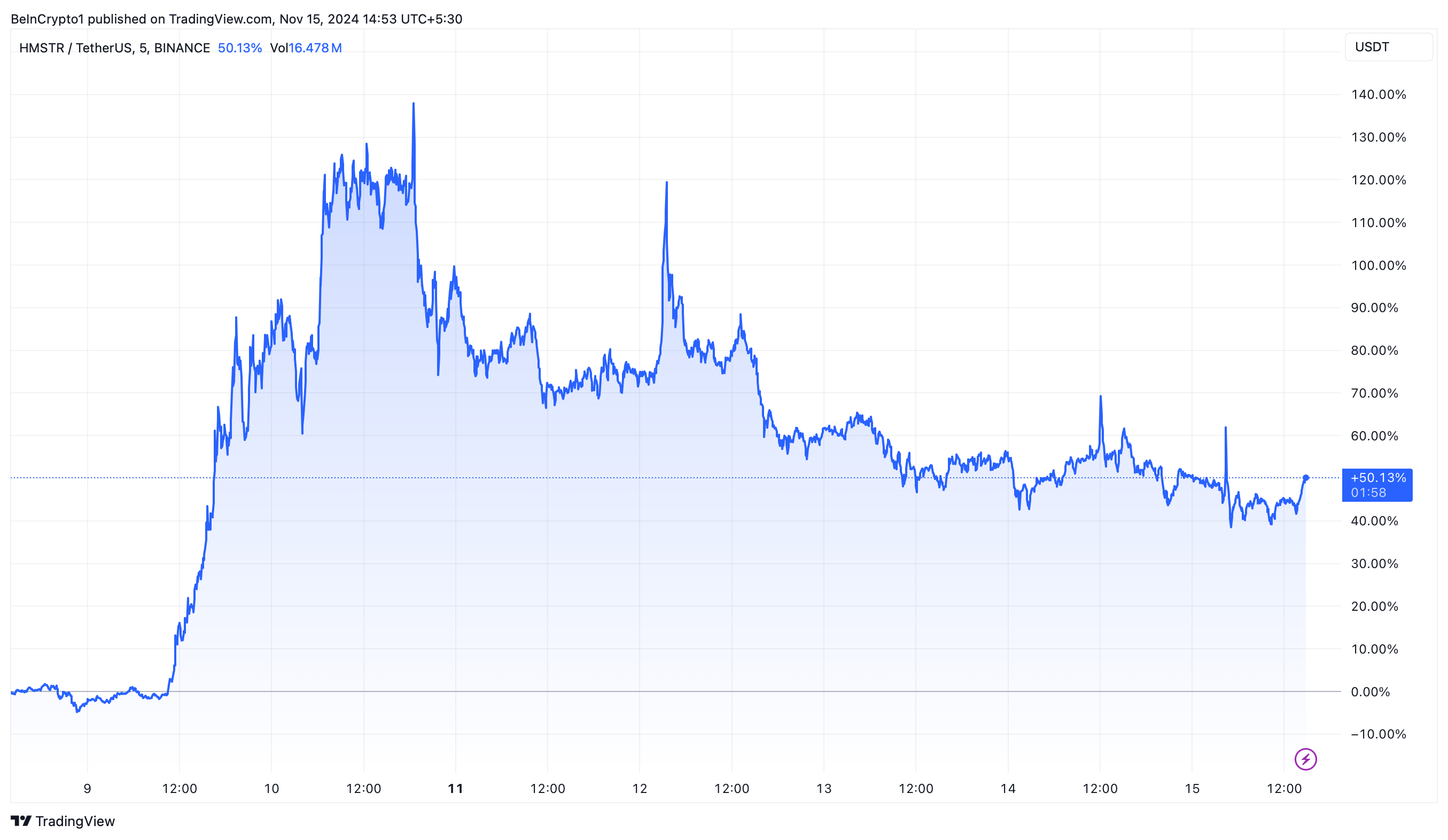
Shiba Inu’s S.H.I.B. Proposal
The Shiba Inu ecosystem is also featured in this week’s crypto trends, following the proposal to create a “Strategic Hub for Innovation and Blockchain” (S.H.I.B.) in the US. As BeInCrypto reported, Shytoshi Kusama, the pseudonymous lead developer of the Shiba Inu network, made the revelation.
The “S.H.I.B.” proposal seeks to transform Shiba Inu into more than just a meme coin by positioning it as a leader in blockchain innovation. The initiative emphasizes fostering a decentralized environment for developers, investors, and tech entrepreneurs.
If successful, this move could elevate the Shiba Inu ecosystem, providing long-term utility for its tokens. It could also reshape perceptions of meme coins in the crypto market.
Kusama’s proposal for a strategic blockchain hub in the US is designed to serve as a “Silicon Valley for crypto.” The estimated budget is $2.35 billion over five to ten years amid plans to establish the US as a global center for blockchain technology and sustainable development. Against this backdrop, the network plans to involve Donald Trump’s Department of Government Efficiency (D.O.G.E), which Elon Musk will co-lead.
“[It is] a visionary approach that our foundation WILL officially propose to this new administration now that this has been announced, and I believe that even a fraction of the funds gathered through D.O.G.E. will pay for these innovations,” Kusama stated.
Binance Listing Drama
Binance, the largest crypto exchange by trading volume metrics, was recently under scrutiny following its decision to list low-cap Solana-based meme coins PNUT and ACT. These tokens experienced sharp price surges post-listing, leading to accusations of market manipulation.
Critics argue that such listings often result in pump-and-dump schemes that benefit insiders. Binance, however, maintains that its listing process is rigorous and aimed at supporting diverse blockchain projects.
This controversy raises questions about centralized exchanges’ responsibilities and transparency, especially in volatile markets dominated by speculative trading.
Notably, the ACT rallied a thousand-fold in the immediate aftermath of the listing announcements. While the controversy caused the tokens to lose some of the ground covered, they are both trying to recoup some of the gains lost.
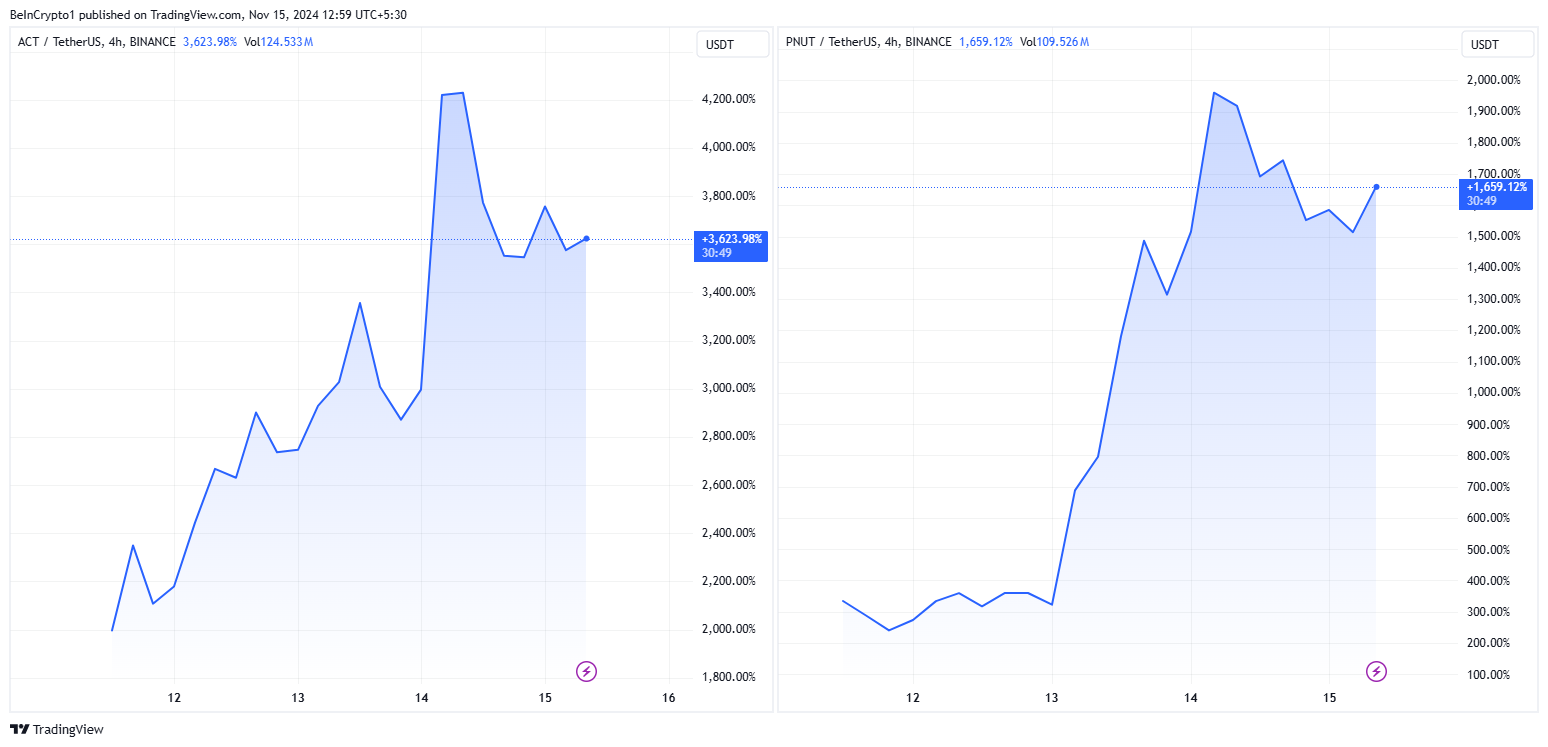
Peter Schiff Calls Out Bitcoin
Renowned economist and Bitcoin skeptic Peter Schiff once again criticized the cryptocurrency. He recently claimed the pioneer crypto lacks intrinsic value and cannot serve as a reliable hedge in economic downturns.
Schiff argues that Bitcoin’s volatility undermines its position as “digital gold,” favoring traditional assets like precious metals instead. While Schiff’s views resonate with many traditional investors, Bitcoin proponents counter. They say that its decentralized nature and finite supply offer unique advantages, particularly in an era of uncertainty about fiat currency.
The Bitcoin skeptic also quashed hopes of a possible Bitcoin reserve in the US, contrary to Donald Trump’s previous assertions. According to Schiff, a Bitcoin reserve in the US would lead to a series of inflationary shocks that could destabilize the economy.
“That would cause the market to crash, forcing the US government to print even more dollars to buy more Bitcoin to prevent the price from crashing, thereby diminishing the value of its Bitcoin reserve. Of course, a reserve of something you can never sell and must continuously buy is worthless as a reserve. To maintain the pretense that its Bitcoin reserve has actual value, the US government would be forced to keep buying, destroying the value of the dollar in the process,” Schiff explained.
More recently, Schiff made another quip at the Trump Media & Technology Group (TMTG), sarcastically urging them to bet on Bitcoin.
El Salvador’s Bitcoin Pivot
Meanwhile, while Peter Schiff remains skeptical about Bitcoin, El Salvador’s decision to adopt BTC as legal tender continues to yield notable benefits. Recent developments reveal that the country leveraged Bitcoin-driven economic gains to repurchase sovereign debt at a discount.
This milestone highlights the potential for cryptocurrency to bolster national finances despite initial skepticism from global financial institutions. President Nayib Bukele’s administration credits Bitcoin’s role in improving tourism, remittances, and investor confidence. This signals the success of the country’s bold experiment in integrating cryptocurrency into national policy.
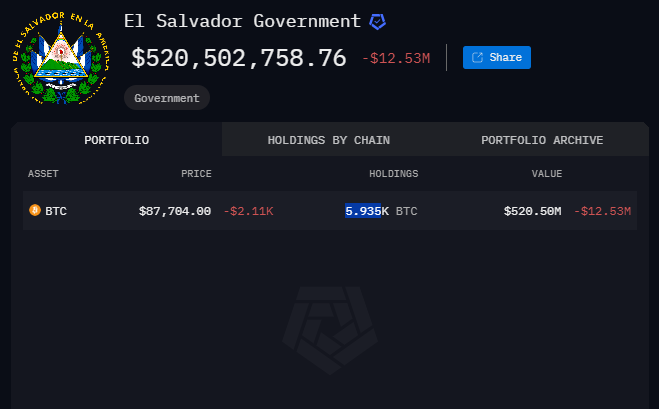
According to data on Arkham, the El Salvador government now boasts a Bitcoin portfolio of 5,935 BTC, which is valued at $520.50 million at current market rates.
Disclaimer
In adherence to the Trust Project guidelines, BeInCrypto is committed to unbiased, transparent reporting. This news article aims to provide accurate, timely information. However, readers are advised to verify facts independently and consult with a professional before making any decisions based on this content. Please note that our Terms and Conditions, Privacy Policy, and Disclaimers have been updated.
Market
Stellar (XLM) Falls 5% as Bearish Signals Strengthen

Stellar (XLM) is down more than 5% on Thursday, with its market capitalization dropping to $8 billion. XLM technical indicators are flashing strong bearish signals, suggesting continued downward momentum that could test critical support levels around $0.22.
While a reversal scenario remains possible with resistance targets at $0.27, $0.29, and $0.30, such an upside move would require a substantial shift in market sentiment.
XLM RSI Shows Sellers Are In Control
Stellar’s Relative Strength Index (RSI) has dropped sharply to 38.99, down from 59.54 just two days ago—signaling a notable shift in momentum.
The RSI is a widely used momentum oscillator that measures the speed and magnitude of recent price changes, typically ranging between 0 and 100.
Readings above 70 suggest overbought conditions, while levels below 30 indicate oversold territory. A reading between 30 and 50 often reflects bearish momentum but is not yet extreme enough to trigger an immediate reversal.

With Stellar’s RSI now below the key midpoint of 50 and approaching the oversold threshold, the current reading of 38.99 suggests that sellers are gaining control.
While it’s not yet in oversold territory, it does signal weakening buying pressure and increasing downside risk.
If the RSI continues to fall, XLM could face further price declines unless buyers step in soon to stabilize the trend and prevent a slide into more deeply oversold levels.
Stellar CMF Heavily Dropped Since April 1
Stellar’s Chaikin Money Flow (CMF) has plunged to -10, a sharp decline from 0.19 just two days ago, signaling a significant shift in capital flow dynamics.
The CMF is an indicator that measures the volume-weighted average of accumulation and distribution over a set period—essentially tracking whether money is flowing into or out of an asset.
Positive values suggest buying pressure and accumulation, while negative values point to selling pressure and capital outflow.

With XLM’s CMF now deep in negative territory at -10, it indicates that sellers are firmly in control and substantial capital is leaving the asset.
This level of negative flow can put downward pressure on price, especially if it aligns with other bearish technical signals. Unless buying volume returns to offset this outflow, XLM could continue to weaken in the near term.
Will Stellar Fall To Five-Month Lows?
Stellar price action presents concerning signals as EMA indicators point to a strong bearish trend with significant downside potential.
Technical analysis suggests this downward momentum could push XLM to test critical support around $0.22. It could breach this level and fall below the psychologically important $0.20 threshold—a price not seen since November 2024.
This technical deterioration warrants caution from traders and investors as selling pressure appears to be intensifying.
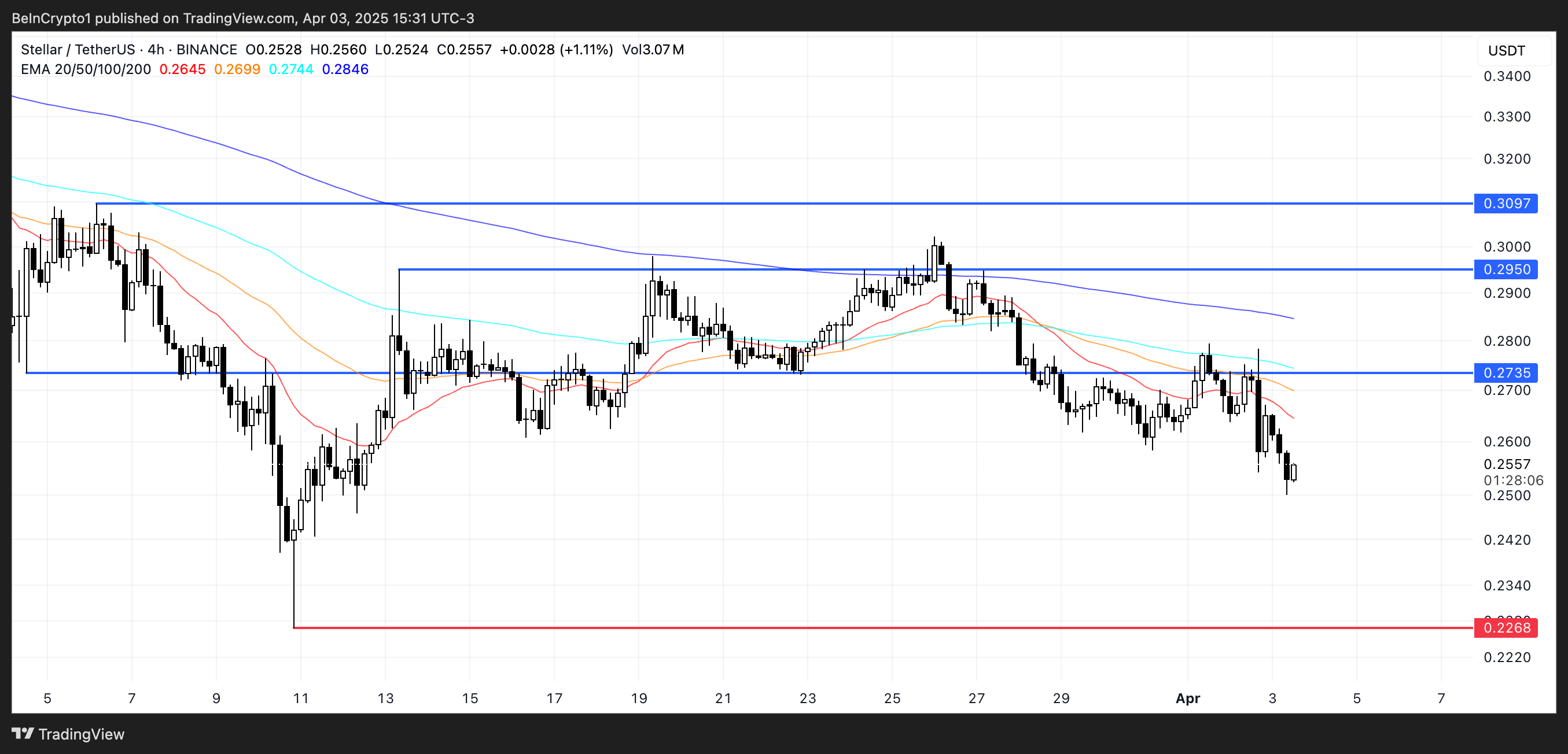
Conversely, a trend reversal scenario would require a substantial shift in market sentiment. Should bulls regain control, XLM could challenge the immediate resistance at $0.27, with further upside targets at $0.29 and the key $0.30 level.
However, this optimistic outlook faces considerable obstacles, as only a dramatic sentiment shift coupled with the emergence of a powerful uptrend would enable such a recovery.
Until clearer bullish signals manifest, the prevailing technical structure continues to favor the bearish case.
Disclaimer
In line with the Trust Project guidelines, this price analysis article is for informational purposes only and should not be considered financial or investment advice. BeInCrypto is committed to accurate, unbiased reporting, but market conditions are subject to change without notice. Always conduct your own research and consult with a professional before making any financial decisions. Please note that our Terms and Conditions, Privacy Policy, and Disclaimers have been updated.
Market
Solana (SOL) Crashes 11%—Is More Pain Ahead?

Solana (SOL) is under heavy pressure, with its price down more than 10% in the last 24 hours as bearish momentum intensifies across key indicators. The Ichimoku Cloud, BBTrend, and price structure all point to continued downside risk, with SOL now hovering dangerously close to critical support levels.
Technical signals show sellers firmly in control, while the widening gap from resistance zones makes a near-term recovery increasingly difficult.
Solana’s Ichimoku Cloud chart is currently flashing strong bearish signals. The price has sharply broken below both the Tenkan-sen (blue line) and Kijun-sen (red line), confirming a clear rejection of short-term support levels.
Both of these lines are now angled downward, reinforcing the view that bearish momentum is gaining strength.
The sharp distance between the latest candles and the cloud further suggests that any recovery would face significant resistance ahead.
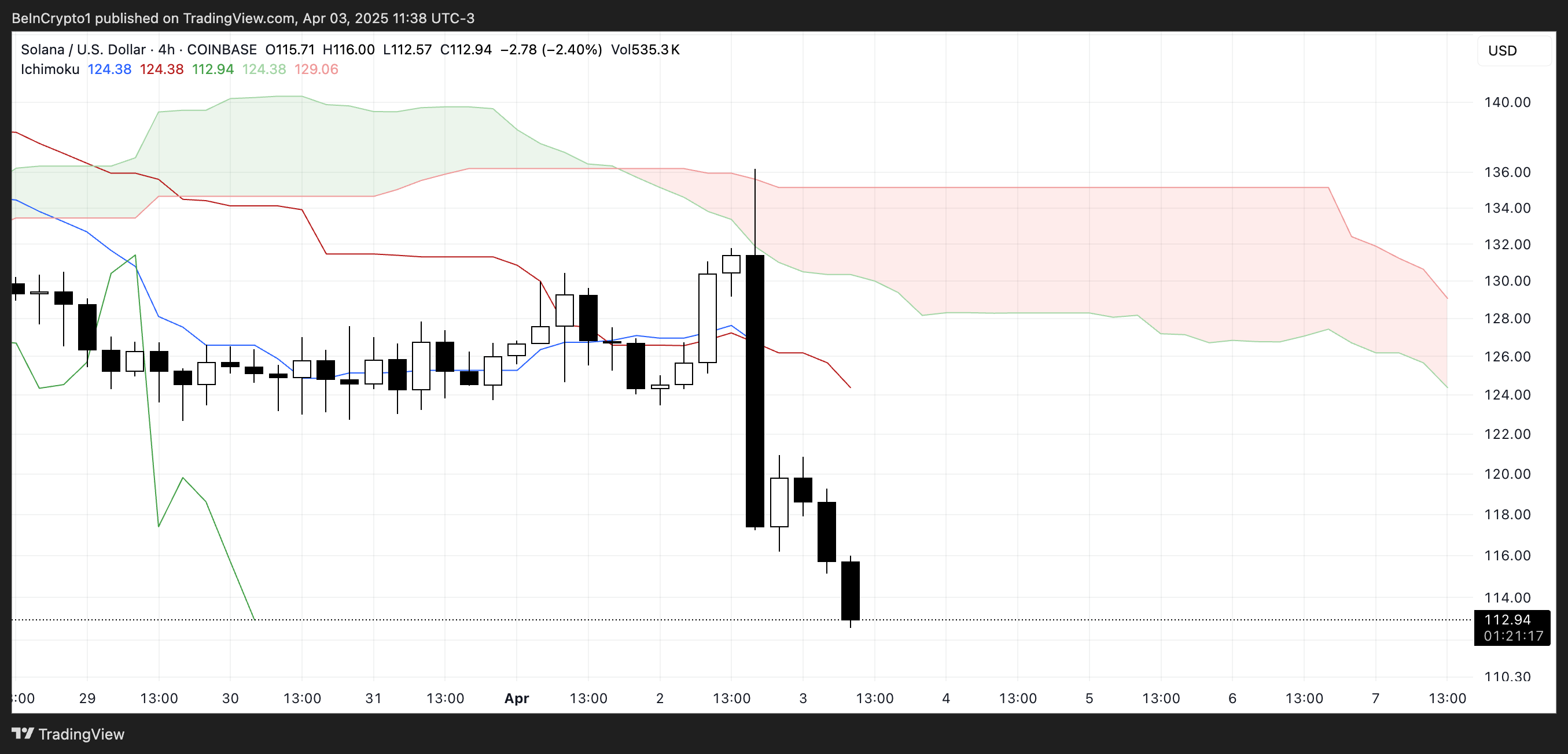
Looking at the Kumo (cloud) itself, the red cloud projected forward is thick and sloping downward, indicating that bearish pressure is expected to persist in the coming sessions.
The price is well below the cloud, which typically means the asset is in a strong downtrend.
For Solana to reverse this trend, it would need to reclaim the Tenkan-sen and Kijun-sen and push decisively through the entire cloud structure—an outcome that looks unlikely in the short term, given the current momentum and cloud formation.
Solana’s BBTrend Signals Prolonged Bearish Momentum
Solana’s BBTrend indicator currently sits at -6, having remained in negative territory for over five consecutive days. Just two days ago, it hit a bearish peak of -12.72, showing the strength of the recent downtrend.
Although it has slightly recovered from that low, the sustained negative reading signals that selling pressure remains firmly in control and that the bearish momentum hasn’t yet been reversed.
The BBTrend (Bollinger Band Trend) measures the strength and direction of a trend using Bollinger Bands. Positive values suggest bullish conditions and upward momentum, while negative values indicate bearish trends.

Generally, values beyond 5 are considered strong trend signals. With Solana’s BBTrend still well below -5, it implies that downside risk remains elevated.
Unless a sharp shift in momentum occurs, this persistent bearish reading may continue to weigh on SOL’s price in the near term.
Solana Eyes $112 Support as Bears Test February Lows
Solana’s price has broken below the key $115 level, and the next major support lies around $112. A confirmed move below this threshold could trigger further downside. That could potentially push the price under $110 for the first time since February 2024.
The recent momentum and strong bearish indicators suggest sellers remain in control, increasing the likelihood of testing these lower support levels in the near term.
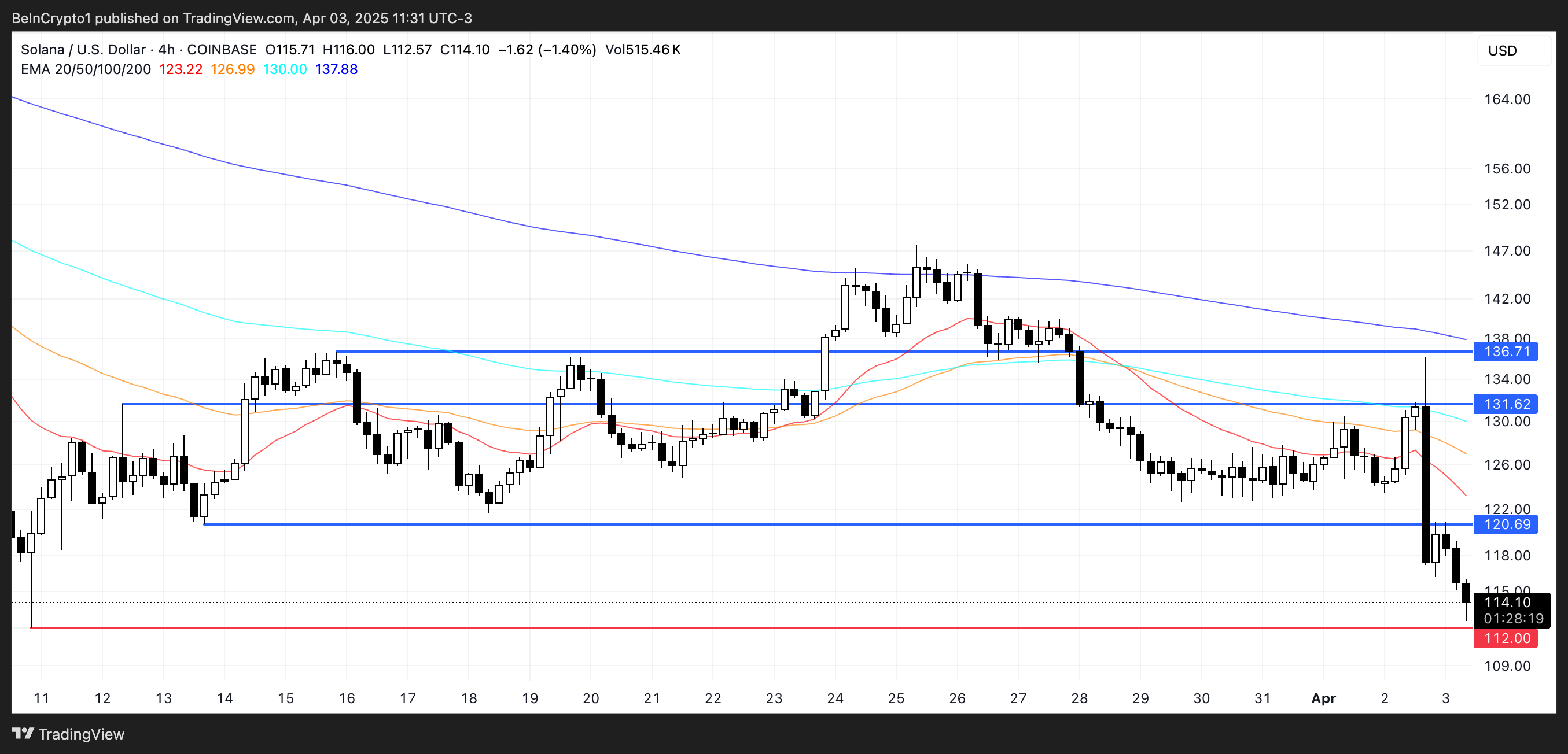
However, if Solana manages to stabilize and reverse its current trajectory, a rebound toward the $120 resistance level could follow.
Breaking above that would be the first sign of recovery, and if bullish momentum accelerates, SOL price could aim for higher targets at $131 and $136.
Disclaimer
In line with the Trust Project guidelines, this price analysis article is for informational purposes only and should not be considered financial or investment advice. BeInCrypto is committed to accurate, unbiased reporting, but market conditions are subject to change without notice. Always conduct your own research and consult with a professional before making any financial decisions. Please note that our Terms and Conditions, Privacy Policy, and Disclaimers have been updated.
Market
Crypto Market Mirrors Nasdaq and S&P 500 Amid Recession Fears
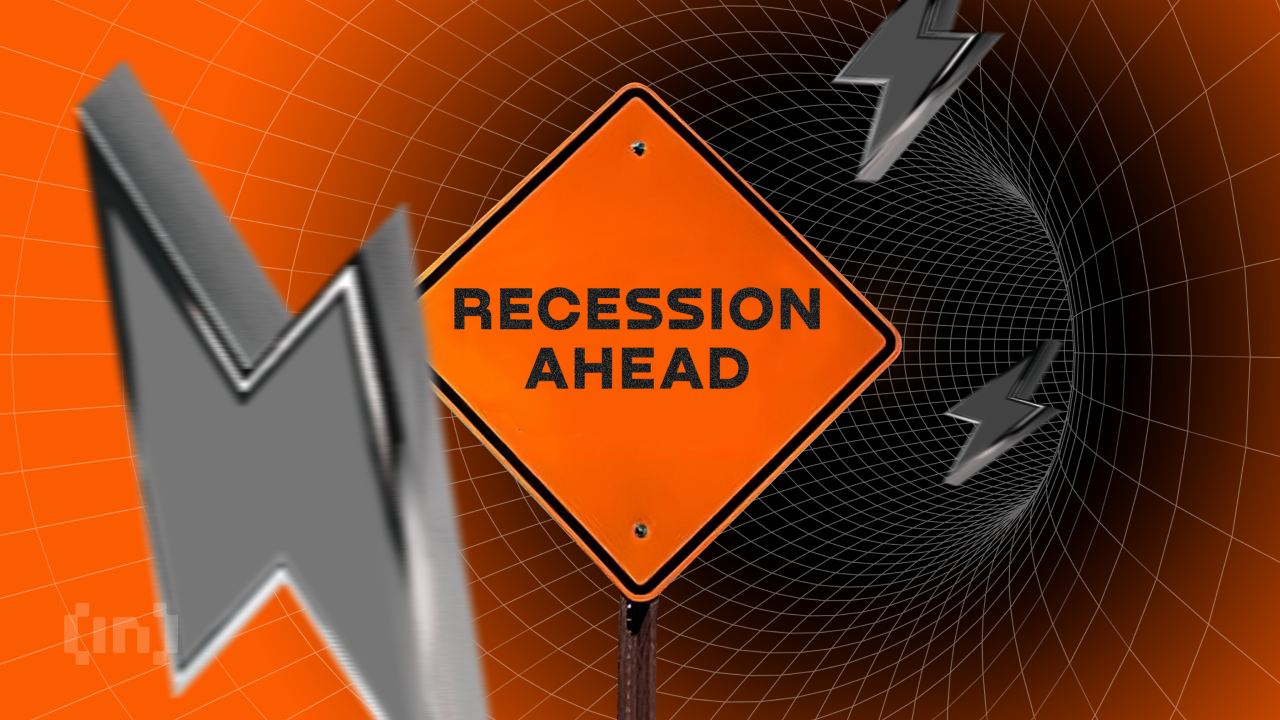
As traditional markets show clear signs of an impending recession, the crypto space is not immune from damage. Liquidations are surging as the overall crypto market cap mirrors declines in the stock market.
Even though the source of these problems is localized to the US, the damage will have global implications. Traders are advised to prepare for a sustained period of trouble.
How Will A Recession Impact Crypto?
Several economic experts have warned that the US market is poised for an impending recession. For all we know, it’s already here.
Since Donald Trump announced his Liberation Day tariffs, all financial markets have taken a real hit. The overall crypto market cap is down nearly 8%, and liquidations in the last 24 hours exceeded $500 million.
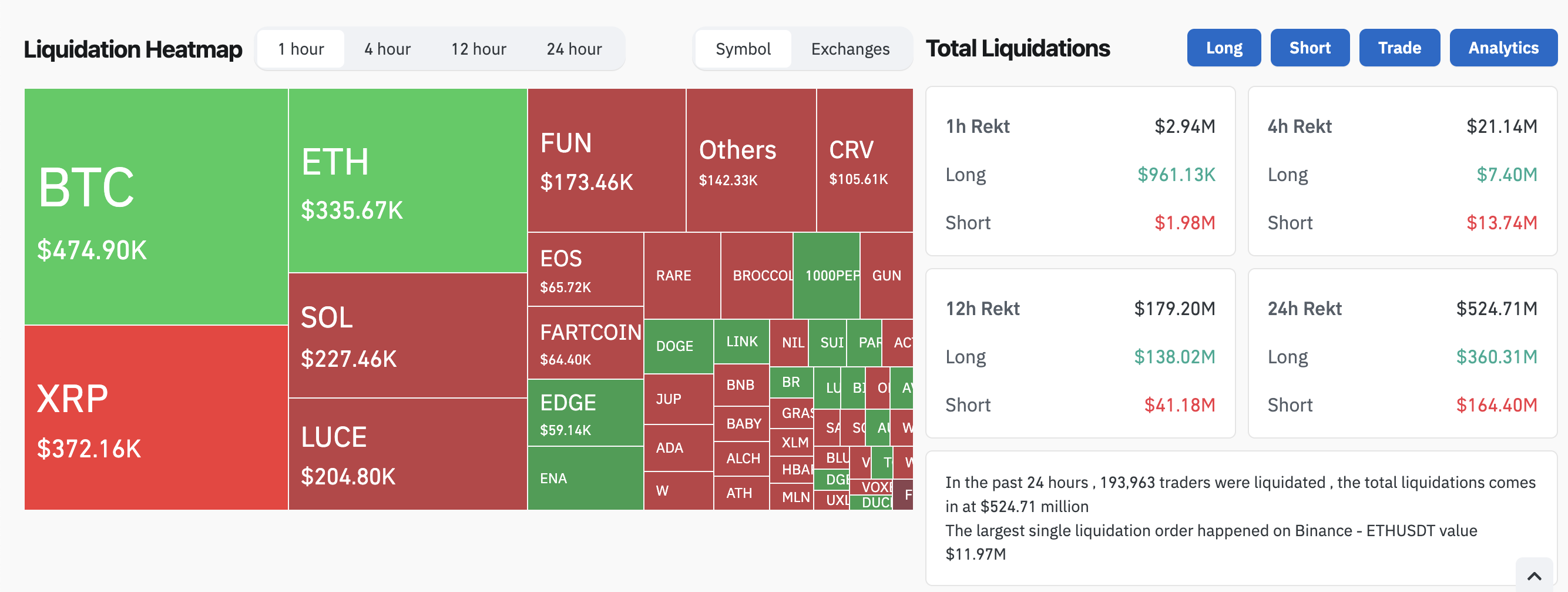
A few other key indicators show a similar trend. In late February, the Crypto Fear and Greed Index was at “Extreme Fear.” It recovered in March but fell back down to this category today.
Similarly, checkers adjacent to crypto, such as Polymarket, began predicting that a recession is more likely than not.
Although the crypto industry is closely tied to President Trump’s administration, it is not the driving force behind these recession fears. Indeed, crypto actually seems to be tailing TradFi markets at the moment.
The Dow dropped 1600 points today, and the NASDAQ and S&P 500 both had their worst single-day drops since at least 2020.
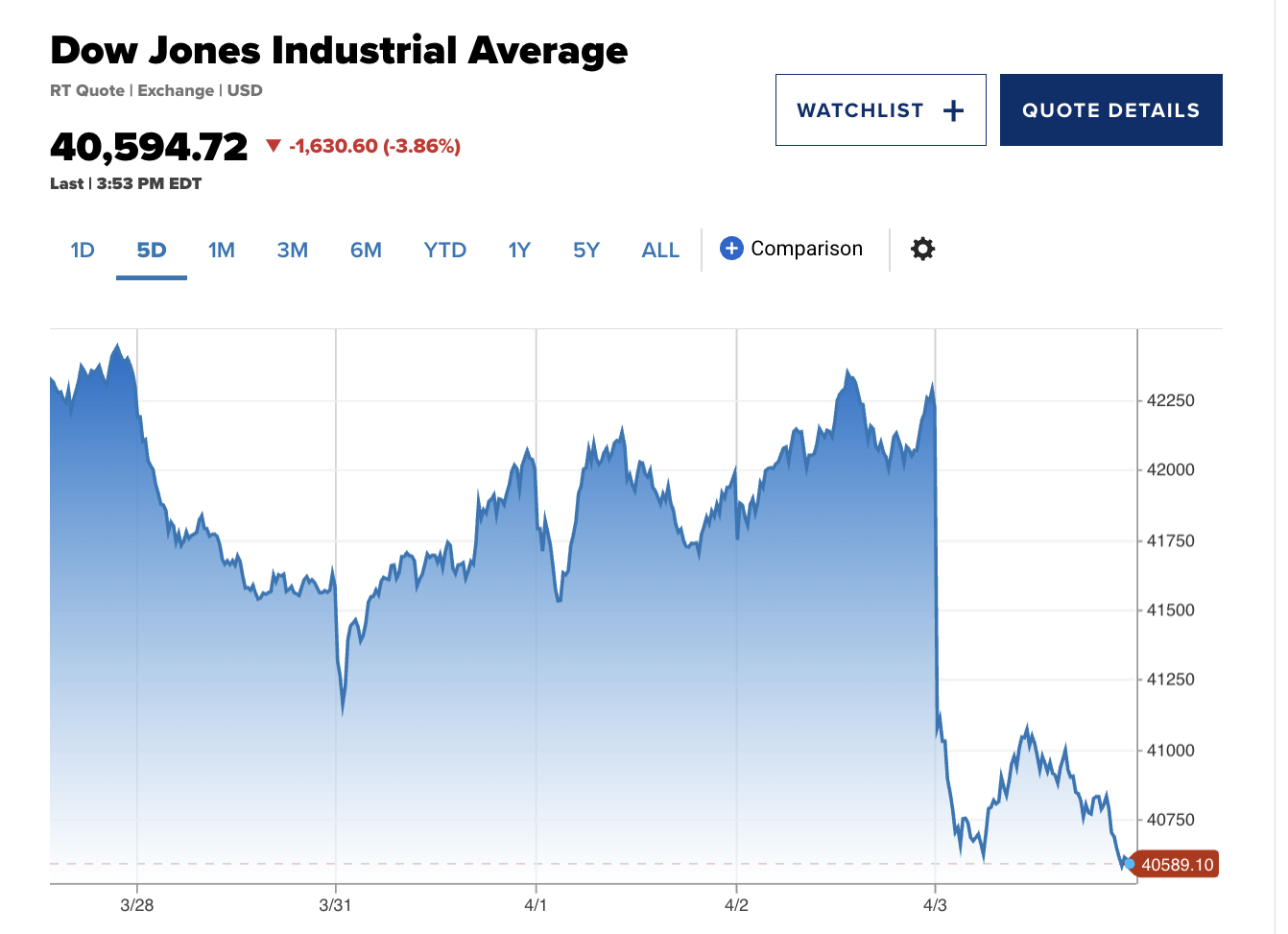
Amidst all these recession fears, it’s been hard to identify an upside for crypto. Bitcoin briefly looked steady, but it fell more than 5% in the last 24 hours.
This doesn’t necessarily reflect its status as a secure store of value, as gold also looked steady before crumbling. To be fair, though, gold has only fallen 1.2% today.
In this environment, crypto enthusiasts worldwide should consider preparing for a recession. Trump’s proposed tariffs dramatically exceeded the worst expectations, and the resultant crisis is centered around the US.
Overall, current projections show that the crypto market will mirror the stock market to some extent. If the Nasdaq and S&P 500 fall further, the implications for risk assets could worsen.
Disclaimer
In adherence to the Trust Project guidelines, BeInCrypto is committed to unbiased, transparent reporting. This news article aims to provide accurate, timely information. However, readers are advised to verify facts independently and consult with a professional before making any decisions based on this content. Please note that our Terms and Conditions, Privacy Policy, and Disclaimers have been updated.
-

 Altcoin23 hours ago
Altcoin23 hours agoBinance Sidelines Pi Network Again In Vote To List Initiative, Here’s All
-

 Altcoin20 hours ago
Altcoin20 hours agoAnalyst Forecasts 250% Dogecoin Price Rally If This Level Holds
-

 Market19 hours ago
Market19 hours agoCardano (ADA) Downtrend Deepens—Is a Rebound Possible?
-

 Market20 hours ago
Market20 hours agoXRP Price Under Pressure—New Lows Signal More Trouble Ahead
-

 Market15 hours ago
Market15 hours agoIP Token Price Surges, but Weak Demand Hints at Reversal
-

 Market23 hours ago
Market23 hours agoXRP Price Reversal Toward $3.5 In The Works With Short And Long-Term Targets Revealed
-

 Market11 hours ago
Market11 hours agoBitcoin’s Future After Trump Tariffs
-
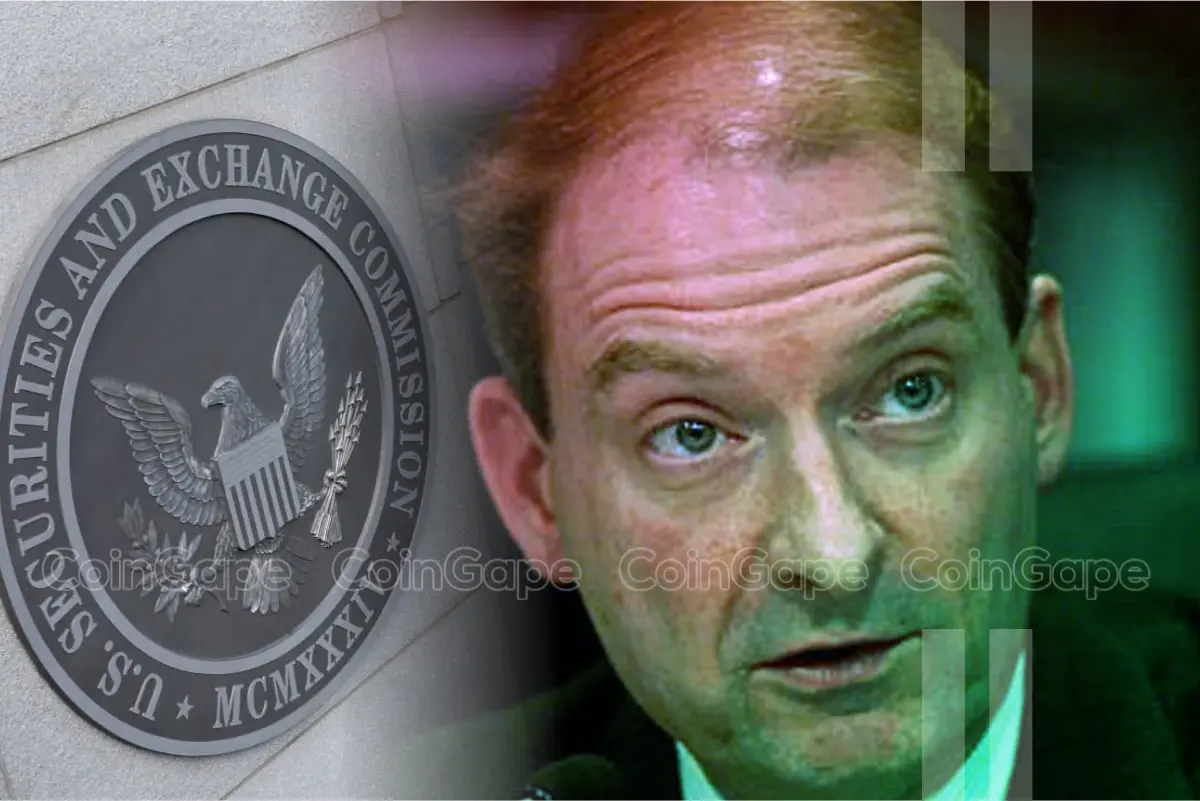
 Regulation10 hours ago
Regulation10 hours agoUS Senate Banking Committee Approves Paul Atkins Nomination For SEC Chair Role


